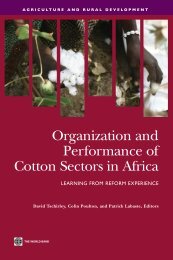Constraints to smallholders participation in Cassava value ... - aaacp
Constraints to smallholders participation in Cassava value ... - aaacp
Constraints to smallholders participation in Cassava value ... - aaacp
You also want an ePaper? Increase the reach of your titles
YUMPU automatically turns print PDFs into web optimized ePapers that Google loves.
market<strong>in</strong>g is necessary for reduc<strong>in</strong>g transaction costs of buyers and <strong>in</strong>creas<strong>in</strong>g the competitivenessof cassava. Similarly, <strong>in</strong>vestment <strong>in</strong> local process<strong>in</strong>g units and the necessary power and watersupplies, which could be small scale community or group-based enterprises, will create employment.1.4 This researchIn January 2010 FAO commissioned from SOAS, University of London a short field study of Zambiansmallholder farmers’ <strong>in</strong>volvement <strong>in</strong> cassava production: (i) <strong>to</strong> contribute <strong>to</strong> an FAO programmeseek<strong>in</strong>g <strong>to</strong> develop an improved understand<strong>in</strong>g of constra<strong>in</strong>ts <strong>to</strong> smallholder market <strong>participation</strong>and of the <strong>in</strong>stitutional <strong>in</strong>novations and policy <strong>in</strong>terventions <strong>in</strong> support of greater <strong>participation</strong>; and(ii) <strong>to</strong> ga<strong>in</strong> <strong>in</strong>sights that might help <strong>to</strong> <strong>in</strong>form the cassava sec<strong>to</strong>r development strategy be<strong>in</strong>gsupported through the EU-funded All ACP Agricultural Commodities Programme (AAACP).Specifically, the TOR were <strong>to</strong> undertake a case study assessment of the extent <strong>to</strong>, and mechanismsthrough which, smallholder <strong>participation</strong> <strong>in</strong> the development of the cassava <strong>value</strong> cha<strong>in</strong> <strong>in</strong> Zambiacan be assured. Us<strong>in</strong>g livelihoods concepts, <strong>in</strong>ter alia, the smallholder production patterns andrecent <strong>in</strong>terventions by the state and by NGOs and <strong>in</strong>itiatives by the private sec<strong>to</strong>r were assessed.The Zambian NGO Programme Aga<strong>in</strong>st Malnutrition (PAM) was contracted <strong>to</strong> collect primary dataaccord<strong>in</strong>g <strong>to</strong> a methodology agreed between SOAS, FAO and PAM. FAO contributed $8000, and afurther $2000 was set apart from SOAS funds received under the Letter of Agreement between FAOand SOAS <strong>to</strong> support the AAACP. Fieldwork was undertaken between February and April 2010. Initialdata analysis was conducted by PAM <strong>in</strong> Lusaka, and then by SOAS <strong>in</strong> London. Results were discussedat meet<strong>in</strong>gs between SOAS and PAM <strong>in</strong> Lusaka <strong>in</strong> mid-May 2010. A presentation was made at theFAO-sponsored workshop on <strong>in</strong>stitutional <strong>in</strong>novations and policy <strong>in</strong>terventions <strong>in</strong> support ofsmallholder market <strong>participation</strong> <strong>in</strong> early June 2010. This report synthesises key lessons from the<strong>in</strong>terim reports by PAM, analysis by SOAS, discussions <strong>in</strong> Lusaka and the presentation anddiscussions <strong>in</strong> Rome (Poole, N.D. et al. 2010).2 Methodology2.1 FrameworkUnderly<strong>in</strong>g this research is a threshold approach <strong>to</strong> livelihoods assets, and the <strong>value</strong> cha<strong>in</strong>relationships between smallholder farmers and the product, market and <strong>in</strong>stitutional environments.Poole and de Frece (2010) suggested a simple typology of two types of <strong>in</strong>ternal <strong>in</strong>itiatives and/orexternal <strong>in</strong>terventions, and <strong>in</strong>stitutional and organisational <strong>in</strong>novations <strong>in</strong> commercial agriculturalmarkets <strong>in</strong> sub-Saharan Africa. Broadly speak<strong>in</strong>g, these <strong>in</strong>novations are aimed at redress<strong>in</strong>g themanagement and organisational weaknesses that impair commercial performance and reduc<strong>in</strong>g thetransaction costs that cause weak or miss<strong>in</strong>g markets. This framework may be employed <strong>to</strong> diagnoseor predict smallholder <strong>participation</strong> <strong>in</strong> different types of markets – such as cassava <strong>in</strong> Zambia. Apartfrom the smallholder growers and their market organisation itself, important dimensions <strong>in</strong>develop<strong>in</strong>g an agricultural economy are the external market and <strong>in</strong>stitutional environment, theproduct and market types <strong>in</strong> respect of technoeconomic characteristics and the potential for povertyreduction. These characteristics can be mapped, on<strong>to</strong> the dimensions of <strong>in</strong>stitutions andorganisations presented <strong>in</strong> Figure 1. As Poole and de Frece (2010: 96) state:`There is a relationship between the product and market type, and the form of marke<strong>to</strong>rganisation and contractual relationships… Markets <strong>in</strong> the bot<strong>to</strong>m left quadrant, arguablymost important for wider poverty reduction, have enjoyed little attention: these are staple8
















